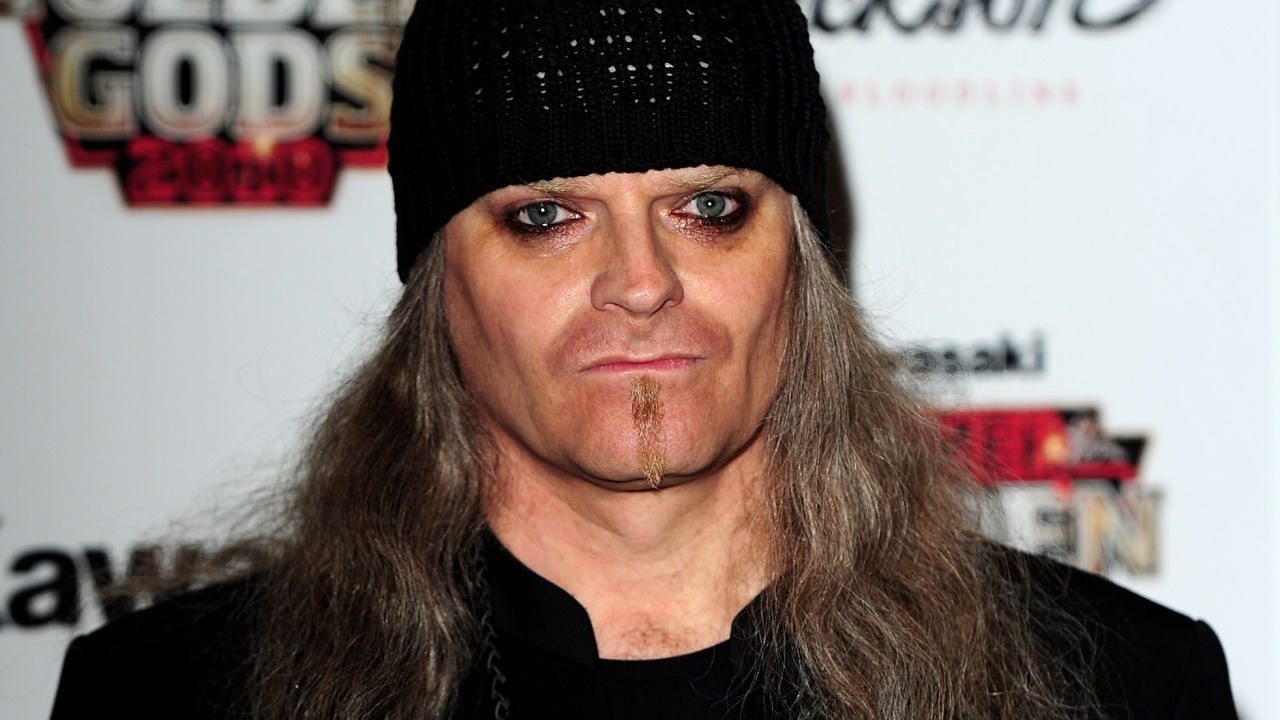When a country remains as neutral as Switzerland has done throughout the years it tends to mean its impact on world culture is not that of the great and evil of the world. In Switzerland’s case you look to Heidi, pocket knives, chocolate, cheese and some pretty good tennis players. As for Swiss rock music? Hmmm, well there was Krokus in the 80s. Coroner are best forgotten. But Celtic Frost were something else.
ALBUM:
APOLLYON SUN
After Celtic Frost finally ground to a halt in the wake of 1990’s Vanity/Nemesis, visionary Thomas Gabriel Fischer took a break from the industry. When he did surface it was with a new act by the name of Apollyon Sun. The final Frost album was to have been called Under Apollyon’s Sun, and though music did reach the demo stage, the album never materialised. Instead, in the mid to late 90s Fischer re-emerged with Coroner drummer and one-time Celtic Frost roadie Marky Edelman, guitarist Erol Unala, bassist Danny Zingg and keyboard player Roger Muller. The band signed with Sanctuary Records and released an EP in 1998 entitled God Leaves (And Dies) and went on to release a full-length album, Sub, in 2000. Musically, Fischer had moved on again and, although it was heavy music, he deployed more industrial and electric themes to the band’s sound. It’s a far cry from Celtic Frost’s avant-metal majesty, but remains an intriguing listen in its own right. An Apollyon Sun website still exists at www.apollyonsun.com, but whether we’ll see anything from them in the future remains a trifle uncertain.
THE ALBUMS…
AVOID!
COLD LAKE
(NOISE, 1988)
Frozen ghost.
Celtic Frost actually ceased to exist at the tail end of 1987, but amazingly Tom G. Warrior was persuaded by Swiss guitarist Oliver Amberg to continue. Almost everyone, Warrior included, wishes he now had not entered Berlin’s Sky Trak studio with producer Tony Platt. For despite the crushing disappointment of the band’s preceding failed US tour and their record label’s shortcomings, this is not the album any band should have followed-up the mighty Into The Pandemonium with. Let’s get one thing straight though – this isn’t a glam metal album. True, Warrior and his newfound band mates looked like the biggest bunch of jessies sashaying down Sunset Strip, but musically it’s mainstream metal – Maiden meets Megadeth if you will. Given metal fans’ notorious narrow-mindedness, the image change was enough to finish the band. There are, however, still one or two decent tunes to be found here.
FANS ONLY
VANITY/NEMESIS
(NOISE, 1990)
Vanity case?
After the disaster that was Cold Lake (little wonder when the band re-issued their back catalogue in 1999 they refused to release that along with their others), it says much about the persistence and never-say-die approach of Frost leader Tom Fischer. Instead of retreating to lick his wounds and remain hidden, he called back Martin Eric Ain and soldiered on. His anger at what befell Frost preceding Vanity/Nemesis is writ large on this new album. Pent-up anger and near-fury explode on the album’s heavier, more thrash metal moments but the mood is often tempered with passages where the band withdraw back to the avant-garde sound of earlier works. There are also two surprising cover versions on offer. A moody take on Bryan Ferry’s This Island Earth actually works, yet when the band tackle Bowie’s Heroes it dies a death. In all honesty, the fire was back, but it was too little, too late.
BOX SET:
THE Eps
Celtic Frost released two immensely influential EPs during the most important years of their career, both of which give a splendid indication of their development over the years. Emperor’s Return was released in 1985, predominantly to allow the band to break in new drummer Reed St. Mark, and amongst its seven tracks you will find an early version of Circle Of Tyrants which would next be reworked on To Mega Therion. The EP was included on the 1999 CD reissue of Morbid Tales. 1986’s Tragic Serenades EP featured only three tracks including a party mix of Return To The Eve, all of which were added to the 1999 CD reissue of To Mega Therion. Needless to say, in their original vinyl format they’re worth a lot.
THE BOOK
Thomas Gabriel Fischer spent much of his time away from the music world busy working on his own memoirs. These saw the light of day as Are You Morbid? Into The Pandemonium With Celtic Frost, which was released by Sanctuary Publishing (at the time Sanctuary Records were releasing Fischer’s Apollyon Sun material) which, needless to say, is mandatory reading for any Celtic Frost fan, although its appeal does actaully stretch beyond the band. Record Collector called it, “Intelligent, humble, questioning, insightful – the cultured side of extreme metal.” From Fischer’s own deprived childhood through the rise of extreme metal, the book is a great read and still available from Amazon for under a tenner.
THE DISCOGRAPHY 1984 – 2006
1984 – Morbid Tales (Noise)
1985 – Emperor’s Return (Noise)
1985 – To Mega Therion (Noise)
1986 – Tragic Serenades (Noise)
1987 – Into The Pandemonium (Noise)
1988 – Cold Lake (Noise)
1990 – Vanity/Nemesis (Noise)
1992 – Parched With Thirst Am I And Dying (Noise)
2006 – Monotheist (Century Media)
WILD CARD
(NOISE, 1984)
Frash-hem.
Early Celtic Frost, with their penchant for corpse face-paint and leather-clad garb, pretty much set the visual tone for the black and death-metal worlds for the next decade. And with their debut album, Morbid Tales, they pretty much laid down the blueprint for the sounds that filled the pages of Subterranea. Given that their previous band, Hellhammer, had proved too constrictive for their own musical visions, it’s perhaps not that surprising that Tom G. Warrior and Martin Eric Ain, along with drummer Stephen Priestly (who would return for Cold Lake) should sound so assured on Celtic Frost’s debut album. Speed metal collides with a proto-grind metal sound on the likes of Procreation (Of The Wicked) (later covered by Sepultura) whilst early avant-garde experiments like Danse Macabre and Return To The Eve gave a hint of just where the band were heading towards next.
RECOMMENDED
(CENTURY MEDIA, 2006)
A masterful return.
Given all the band achieved in a relatively short first stint with the metal world, expectations for Celtic Frost’s return were inevitably high. Yet anyone who knows the band would know that Tom Fischer and Martin Eric Ain (joined by drummer Franco Sesa) would equally give themselves one enormous benchmark to reach even just to use the Frost name again. With Monotheist they more than achieved their goal: a great metal album that throws all the major facets of their power into play. Progeny is dark, doom-laden thrash, Drown In Ashes gothic-tinged death and A Dying God Coming Into Human Flesh even manages to inflect melody into its darkest passages. The closing Triptych, at over 20 minutes, is perhaps most challenging of all, throwing all but the proverbial kitchen sink into the mix. Yet as with much of what Celtic Frost have ever achieved, it’s breathtakingly powerful all the same.
SILVER MEDAL
(NOISE, 1985)
Beastly.
The title refers to the Great Beast (in as much as that’s a direct translation from the Greek), which in Frost’s case could mean Satan himself, or perhaps occult pioneer Aleister Crowley, who often referred to himself under the same name. Both have been hugely influential to a band like Celtic Frost for lyrical inspiration, and coming housed in a sleeve designed by Swiss artist extraordinaire H.R. Giger (who designed sets for Alien), To Mega Therion would set the tone for all that Celtic Frost would later achieve, lose and much later reclaim. Like their debut, it’s thunderously heavy stuff, a brutal death-metal storm. Yet interspersed throughout are the elements that would make its successor so great. Classical infusions, wailing choirs and operatic arias blend throughout with Frost’s intense musical vision – never interfering with the thrust of spine-shivering entries like Circle Of Tyrants or Dawn Of Megiddo.
MUST HAVE
INTO THE PANDEMONIUM
(NOISE, 1987)
Metal mayhem.
Even if the advancements Celtic Frost had made musically since their 1984 Morbid Tales debut were considered, quite rightly, by the metal press as a serious advancement in sound, the band had, up until the release of their third long player, merely hinted at what they were capable of. If you consider that in the space of two albums and two EPs they’d turned thrash metal on its head and laid down the blueprint for what we now know as both death and black metal, then the world should have been their proverbial oyster with the release of 1987’s Into The Pandemonium. But mainstream acceptance and Celtic Frost were never bedfellows. So it really is some considerable achievement that Into The Pandemonium is the album that secured Celtic Frost their lasting legacy.
As with most Frost releases, much of this album is thunderously heavy, the likes of Inner Sanctum keeping the thrash heads happy. Yet everywhere there was change too. The band’s cover of alt-rockers Wall Of Voodoo’s Mexican Radio kicks things off. Despite its brutal execution, it shows they were not afraid to take risks. But what would Frost fans make of risks like the lone female French vocals and strings of Tristesse De La Luna? Of the classical and operatic approach of Rex Irae (Requiem)? Of the dance-laden themes of I Won’t Dance? Or of Tom Warrior’s eschewing his trademark rasp for a crooning lilt on Mesmerised?
Because Celtic Frost had never lost sight of their vision, the fans, and critics, lapped it up. The term ‘avant-garde metal’ was coined and it suited the band perfectly. Into The Pandemonium is heavy but not just metal, breathtaking from start to finish, and something to revel in.

